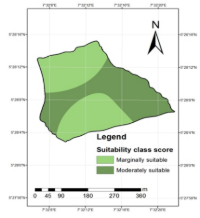Evaluation of regenerating ability of mushroom (Pleurotus tuber regium) in Southern Nigeria
Main Article Content
Abstract
A screen house experiment was conducted at the Department of Crop Science, Akwa Ibom State University, Obio Akpa Campus to evaluate the effects of organic substrates (sawdust, poultry manure, horse dung and oil palm bunch refuse) and tuber regium weights (10g, 20g, 30g,40g and 50g) on performance of Pleurotus tuber regium. The experiment was a 4 x 5 factorial combination fitted into a completely randomized design (CRD) and replicated three times. Data collected were subjected to analysis of variance (ANOVA) at 5% probability level. The results of the study showed significant differences (p<0.05) on Pleurotus tuber regium yield and regenerating abilities. The oil palm bunch substrate had highest stripe height 4.90 cm, 6.58 cm cap diameter and highest mushroom yield of 339.45grams per 2 kg substrate while sawdust substrate had the shortest stripe 3.09cm and poultry manure had the lowest cap diameter of 4.70cm and the least mushroom weight of 155.10g was obtained from poultry manure. The result indicated that oil palm bunch substrate resulted to 43-54% increases in mushroom yield while the least regenerating ability was observed from poultry manure substrate 50g tuber weight had 60-74% highest Pleurotus tuber regium yield as compared to others. The study therefore recommends oil palm bunch substrate with 50g tuber regium for high yield and regenerating ability of mushroom.
Downloads
Article Details
Issue
Section

This work is licensed under a Creative Commons Attribution-NonCommercial-ShareAlike 4.0 International License.
How to Cite
References
Akpan, E. A. (2009). Effect of agronomic practices on the performance of oyster mushroom Pleuroutus tuber
regium in Uyo, Akwa Ibom State, Unpublished Ph.D. Dissertation.
Akpan, E. A. (2015). Effect of plantable sizes and environment on growth and yield of Pleuroutus tuber
regium in Southern Nigeria. In Akpan E. A. and Udoh V. S. 59th Annual Gene ral me e ting of Association of Dean of Agriculture in Nigeria Universities (ADAN).
Akpan, E. A. (2016). Effect of different sizes of planting materials on the growth and yield components of
mushroom Pleurotus tuber regium.
Aman, S., Ravinder, C. & Vikrant, S. (2002). Some n ema t o d e o f mushroom and their management. Annals of Agriculture and Biological Research, 7: 51-52.
Cohen, R. Persky, L. & Hadar, Y. (2004). Biotechnological applications and potential of woods degrading mushrooms of the Genus Pleurotus. Applied Microbiological and Biotechnology, 58 (5): 582 - 594.
Enwezor, W. O. Udo E. J., Avorode K. A. Adepetus, J. A. & Chade, V. O. (1990). A review of soil and fertilizer use research in Nigeria, Vol. 4. Middle Belt Zone Federal
Ministry of Agriculture and Natural Resources. p. 217.
Haas, E. M. & James, P. (2009). More vegetable, fruits delicious recipes for eating healthy foods each and every day. Oakland, California : New Harbinger Publications, P. 22.
Miles, P. G. & Chang, S. T. (2004). Mushroom Cultivation Nutritional Value, Medicinal Effect and Environmental Impact BOCA Raton Florida CRC Press.
Slus-Ak (1989). Physical Background, soil and landuse and ecological problems. Technical Report of the
task force on soil and landuse survey Akwa Ibom State, The Government Printer, Uyo.
Udo, I. O. & Akpan, E. A. (2012). Effect of Different Sizes of Planting Materials on the Growth and Yield Component of Edible mushroom (Pleurotus tuber regium). Global
Journal of Agricultural Sciences.Bachudo Science Co. Ltd. Printed in Nigeria. (2):1 – 33-35.


